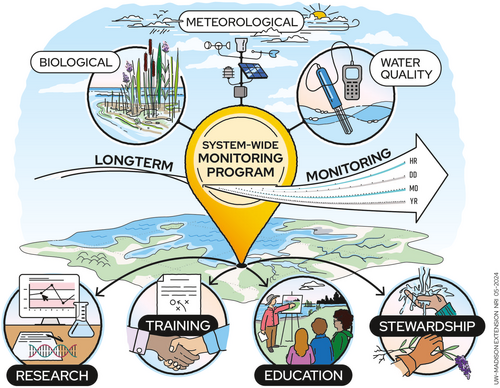Long-term research data collected by the National Estuarine Research Reserve System (NERRS) facilitate critical new discoveries and a better understanding of the natural world and waterways. The ability to access research data across an extended timespan greatly increases our understanding of ecosystems and the changes our natural and built worlds have experienced over time.
“The information we gain from long-term studies allows us to address issues at the local scale like harmful algal blooms just down the road at a popular beach up to continental scale trends in eutrophication and hypoxia,” said Kaitlin Reinl, Research Coordinator for the Lake Superior National Estuarine Research Reserve in Superior, Wis., one of the 30 NERRS nationally and administered in Wisconsin by UW–Madison Extension. “Investments in long-term data collection in the state of Wisconsin, such as the System-Wide Monitoring Program and the Long-term Ecological Research Program, are directly showing up in Wisconsin communities by creating jobs, addressing community challenges using data-driven approaches, and educating K-12 students in STEM.”

A new article published in the Journal of Geophysical Research: Biogeosciences highlights the transformative impact of long-term research and monitoring in the NERRS. The reserve system is a network of 30 coastal sites designated to protect and study estuarine systems – and each participate in long-term research through the System-Wide Monitoring Program. The article underscores the importance of the reserve’s System-Wide Monitoring Program which has sampling stations at reserves distributed across the Atlantic, Pacific, Gulf, and Great Lakes coasts, including Alaska, Hawaii, and Puerto Rico, and occupy multiple climate zones. This kind of long-term monitoring is unique in that it can be used alongside other long-term surveys to provide more context for short-term studies while also helping local communities answer critical research questions.
Data collected as part of this program are freely available to the public and have many different applications for both basic research and applied science to address management needs. As computing power and data-intensive analysis techniques advance, the value of high-frequency, long-term environmental data will continue to grow. The NERRS System-Wide Monitoring Program is poised to play a pivotal role in ecological forecasting, machine learning applications, and remote sensing studies.
Examples of key research findings that would not have been possible without the NERRS System-Wide Monitoring Program include:
- Research showing that metabolic processes are a critical driver of pH and dissolved oxygen variability in shallow estuarine ecosystems.
- Novel metrics to evaluate tidal marsh resilience to sea-level rise enabling local decision-makers to better understand the climatological risk to their coastal wetlands when developing coastal management strategies.
- Data clarifying the relationship between shrimp abundance and water temperature, revealing that the critical temperature needed to open spring fisheries may need to be increased from 9°C to 11°C to more effectively protect shrimp spawning stocks.
- Research demonstrating that changes to coastal land use and climate can drastically lower oxygen in estuarine nursery habitats fundamentally altering the diversity and functioning of coastal nurseries and indirectly affecting offshore fisheries.
The NERRS, established through the U.S. Coastal Zone Management Act, encompasses 1.4 million acres of coastal habitat across 30 reserves. This unique system bridges the gap between scientific research and applied management, leveraging partnerships with federal, state, and local stakeholders to address pressing environmental issues.
For more information contact Kaitlin Reinl, Research Coordinator, UW – Madison Extension Lake Superior National Estuarine Research Reserve, at kreinl@wisc.edu or (715) 399-4087.




